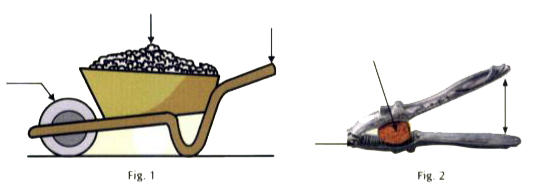The MA of a class-one lever is
always less than 1
always greater than 1
greater than or less than 1
always equal to 1
To solve the question regarding the Mechanical Advantage (MA) of a class-one lever, we will follow these steps:
Step 1: Understand the Concept of Mechanical Advantage (MA)
Mechanical Advantage (MA) is defined as the ratio of the load force (output) to the effort force (input) in a machine. It indicates how much a machine multiplies force.
Step 2: Identify the Components of a Class-One Lever
A class-one lever consists of three main components:
- Fulcrum: The pivot point around which the lever rotates.
- Load: The object that is being lifted or moved.
- Effort: The force applied to move the load.
Step 3: Analyze the Position of the Fulcrum
In a class-one lever, the position of the fulcrum can vary:
- If the fulcrum is closer to the load, the effort needed to lift the load is less, resulting in an MA greater than 1.
- If the fulcrum is closer to the effort, the effort needed to lift the load is more, resulting in an MA less than 1.
- If the fulcrum is positioned such that the effort and load are balanced, the MA can be equal to 1.
Step 4: Conclusion
Based on the analysis, the Mechanical Advantage (MA) of a class-one lever can be:
- Greater than 1 (when the fulcrum is closer to the load),
- Less than 1 (when the fulcrum is closer to the effort),
- Or equal to 1 (when the fulcrum is in a balanced position).
Thus, the correct answer to the question is that the MA of a class-one lever is greater than or less than 1.
Final Answer
The MA of a class-one lever is greater than or less than 1.
---
Mechanical Advantage (MA) is defined as the ratio of the load force (output) to the effort force (input) in a machine. It indicates how much a machine multiplies force.
A class-one lever consists of three main components:
- Fulcrum: The pivot point around which the lever rotates.
- Load: The object that is being lifted or moved.
- Effort: The force applied to move the load.
In a class-one lever, the position of the fulcrum can vary:
- If the fulcrum is closer to the load, the effort needed to lift the load is less, resulting in an MA greater than 1.
- If the fulcrum is closer to the effort, the effort needed to lift the load is more, resulting in an MA less than 1.
- If the fulcrum is positioned such that the effort and load are balanced, the MA can be equal to 1.
Based on the analysis, the Mechanical Advantage (MA) of a class-one lever can be:
- Greater than 1 (when the fulcrum is closer to the load),
- Less than 1 (when the fulcrum is closer to the effort),
- Or equal to 1 (when the fulcrum is in a balanced position).
The MA of a class-one lever is greater than or less than 1.
Topper's Solved these Questions
- ENERGY BOOK - ICSECHAPTER - ENERGY EXERCISE - Exercises Section I (Write T for True and F for False. Correct the False statements)
6 Videos
- ENERGY BOOK - ICSECHAPTER - ENERGY EXERCISE - Exercises Section I (Choose the correct option to fill in the blank)
5 Videos
- ENERGY BOOK - ICSECHAPTER - ENERGY EXERCISE - Exercises Section I (Name the following)
10 Videos
- FORCEBOOK - ICSECHAPTER - FORCEEXERCISE - Picture Based Questions
2 Videos
Similar Questions
Class-two levers
View SolutionGive an example of each class of lever in a human body.
View SolutionExplain why mechanical advantage of a class II lever is always more than 1.
View SolutionHow is it possible to increase the M. A. of the above lever without increasing its length ?
View SolutionDraw a labelled sketch of a class III lever. Give one example of this kind of lever.
View SolutionThe diagram alongside shows a lever in use :
To which class of levers does it belong ?

View SolutionThe diagram below shows a lever in use :

To which class of levers does it belong ?
View Solution
The machines shown above are class-two levers . What does this mean ?
View SolutionThe diagram below shows a rod lifting a stone.
(a) Mark position of fulcrum F and draw arrows to show the directions of load L and effort E. (b) What class of lever is the rod ? (c) Give one more example of the same class of lever stated in part (b).
 .
.
View SolutionGive one example each of a class I lever where mechanical advantage is (a) more than 1, and (b) less than 1.
View Solution
